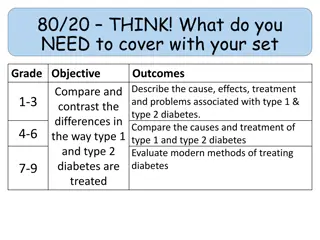Understanding Type 1 Diabetes Pathophysiology and Etiology
Type 1 diabetes is characterized by absolute insulin deficiency, resulting from pancreatic beta cell destruction. It is prone to ketosis with a total deficit of circulating insulin, often due to autoimmune factors. The pathophysiology involves inflammation, immune-mediated cell destruction, and a chronic autoimmune response targeting pancreatic cell antigens. Genetic susceptibility and environmental factors play a role in triggering the autoimmune reaction seen in type 1 diabetes. Various autoantibodies, such as islet cell antibodies and anti-insulin antibodies, are commonly found in patients with type 1 diabetes. Trends indicate an increasing prevalence of certain autoantibodies at diagnosis, suggesting a more intense humoral autoimmune response in the pathogenesis of the disease.
Download Presentation

Please find below an Image/Link to download the presentation.
The content on the website is provided AS IS for your information and personal use only. It may not be sold, licensed, or shared on other websites without obtaining consent from the author. Download presentation by click this link. If you encounter any issues during the download, it is possible that the publisher has removed the file from their server.
E N D
Presentation Transcript
Pathophysiology of Type 1 Diabetes 1
Type 1 Diabetes Mellitus Characterized by absolute insulin deficiency Pathophysiology and etiology Result of pancreatic beta cell destruction Prone to ketosis Total deficit of circulating insulin Autoimmune Idiopathic 2
Type of Diabetes in Youth by Race/Ethnicity and Etiology SEARCH for Diabetes in Youth Study (N=2291) 100% 6.2 15.9 11.1 28.3 categories by race/ethnicity 80% 40.1 40.8 Distribution of etiologic 10.1 19.8 6.6 67.8 19.5 60% Non-autoimmune + IR Non-autoimmune + IS Autoimmune + IR Autoimmune + IS 9.4 21.3 10.8 18 15.1 40% 62.9 3.2 54.5 12.9 43.7 20% 33.3 32.5 16.1 0% NHW Hispanic AA API AI Total AA, African American; AI, American Indian; API, Asian/Pacific Islander; IR, insulin resistant; IS, insulin sensitive; NHW, non-Hispanic white. 3 Dabelea D, et al. Diabetes Care. 2011;34:1628-1633.
Type 1 Diabetes Pathophysiology Inflammation -cell destruction Usually leading to absolute insulin deficiency Immune mediated Idiopathic FasL IFN- TNF- T cell Autoimmune Reaction Macrophage TNF- Class II MHC Class I MHC IL-1 -cell NO CD8+ T cell Dendritic cell -cell Destruction CD8, cluster of differentiation 8; FasL, Fas ligand; IFN- , interferon ; IL-1, interleukin 1; MHC, major histocompatibility complex; NO, nitric oxide; TNF- , tumor necrosis factor . 4 Maahs DM, et al. Endocrinol Metab Clin North Am. 2010;39:481-497.
Pathophysiologic Features of Type 1 Diabetes Chronic autoimmune disorder Occurs in genetically susceptible individuals May be precipitated by environmental factors Autoimmune response against Altered pancreatic -cell antigens Molecules in -cells that resemble a viral protein Antibodies Approximately 85% of patients: circulating islet cell antibodies Majority: detectable anti-insulin antibodies Most islet cell antibodies directed against GAD within pancreatic -cells GAD, glutamic acid decarboxylase. 5 Maahs DM, et al. Endocrinol Metab Clin North Am. 2010;39:481-497.
Trends in T1D Immunophenotype at Diagnosis Prevalence of IA-2A and ZnT8A has increased significantly, mirrored by raised levels of IA-2A, ZnT8A, and IA-2 autoantibodies (IA-2 A) IAA and GADA prevalence and levels have not changed Increases in IA-2A, ZnT8A, and IA-2 A at diagnosis during a period of rising incidence suggest that the process leading to type 1 diabetes is now characterized by a more intense humoral autoimmune response Autoantibodies to insulin, IAA; GAD, GADA; islet antigen-2, IA-2A; T1D, type 1 diabetes; zinc transporter 8, ZnT8A. 6 Long AE, et al. Diabetes. 2012;61:683-686.
Autoimmune Basis for Type 1 Diabetes Immune dysregulation Environmental triggers and regulators IAA GADA, ICA512A, ICA Interactions between genes imparting susceptibility and resistance -Cell mass Loss of first-phase insulin response (IVGTT) Variable insulinitis -cell sensitivity to injury Glucose intolerance Overt T1D C-peptide undetec- table Prediabetes Time 7 Atkinson MA. Diabetes. 2005;54:1253-1263. Adapted from Atkinson MA, Eisenbarth GS. Lancet. 2001;358:221-229.
Models for Pathogenesis of T1D 8 van Belle TL, et al. Physiol Rev. 2011;91:79-118.
Models for Pathogenesis of T1D 9 van Belle TL, et al. Physiol Rev. 2011;91:79-118.
Models for Pathogenesis of T1D: Fertile Field Hypothesis 10 van Belle TL, et al. Physiol Rev. 2011;91:79-118.
How Type 1 Diabetes Might Arise 11 van Belle TL, et al. Physiol Rev. 2011;91:79-118.
Insulin and Glucose Metabolism Major Metabolic Effects of Insulin Stimulates glucose uptake into muscle and adipose cells Inhibits hepatic glucose production Consequences of Insulin Deficiency Hyperglycemia osmotic diuresis and dehydration 12
Major Metabolic Effects of Insulin and Consequences of Insulin Deficiency Insulin effects: inhibits breakdown of triglycerides (lipolysis) in adipose tissue Consequences of insulin deficiency: elevated FFA levels Insulin effects: inhibits ketogenesis Consequences of insulin deficiency: ketoacidosis, production of ketone bodies Insulin effects in muscle: stimulates amino acid uptake and protein synthesis, inhibits protein degradation, regulates gene transcription Consequences of insulin deficiency: muscle wasting 13























